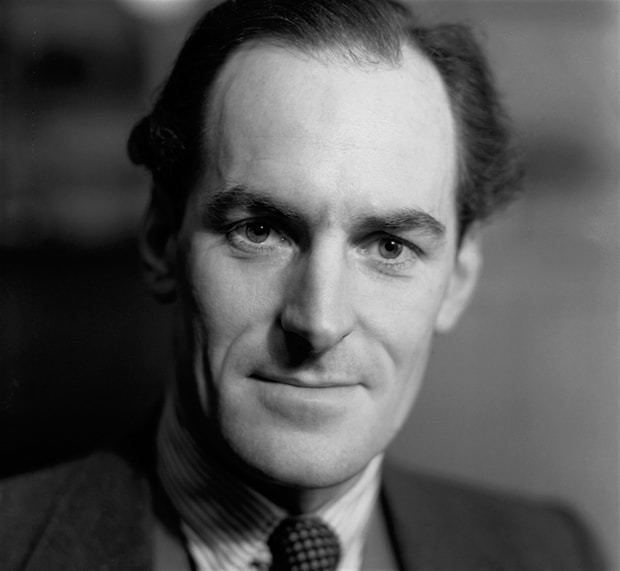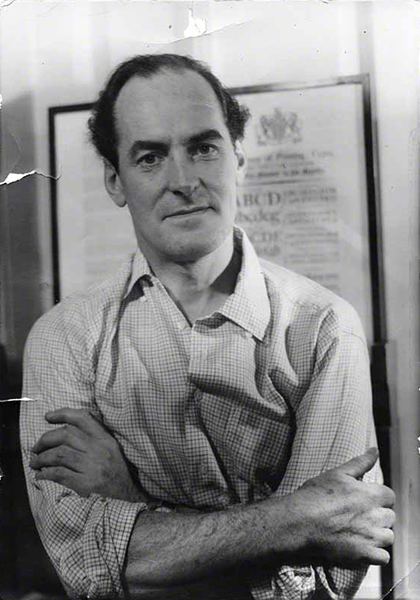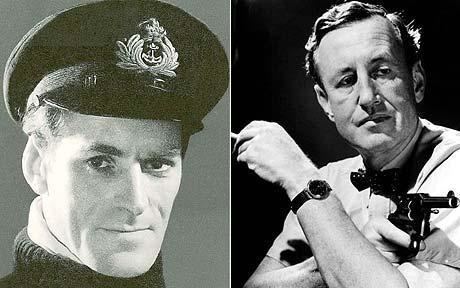Name Robert Harling | Role Journalist | |
 | ||
Books The enormous shadow, The Hollow Sunday, The Athenian Widow: A Novel | ||
Up next steel magnolias with robert harling cocktails classics
Robert Henry Harling (London 27 March 1910 – 1 July 2008 Godstone, Surrey) was a British typographer, designer, journalist and novelist who lived to the age of 98.
Contents
- Up next steel magnolias with robert harling cocktails classics
- Early life and work
- World War Two The Royal Navy and Ian Fleming
- Immediate Post War Career
- House Garden
- Later life
- Selected Books and other work
- Selected Achievements
- Fonts
- References

Early life and work

Robert Harling's success came despite an unpromising upbringing. He was born in Highbury, London, in 1910, and was orphaned at an early age being brought up by his mother's friend, a nurse whom he regarded as an aunt. After her marriage they moved to Brighton, bringing him in contact with the Royal Pavilion, and a lifelong appreciation for architecture and design, and the Sea, where he learnt to swim and sail. With the death of his uncle he returned to Islington with his aunt, and was enrolled in Owen's School. This was the story he put about. "Later research showed this was complete invention. He grew up and went to school in Islington, with a living mother and a father who drove a London taxi. He had a brother and a first wife who, like his parents, had been ruthlessly excised by Harling from his biography, and came as a revelation to his middle-aged children."
He attributed his interest in lettering from his study of Pears' Cyclopaedia, which he was given on his 12th birthday. He was fascinated by the reproductions of assay marks for plate, fine examples of English vernacular lettering. His "uncle" would enlarged them for him photographically so he could laboriously copy them. This love of letter-forms and contemporary gothic led him to the Central School of Arts and Crafts, having rejected a place at Oxford.
He briefly kept a bookshop in Lamb's Conduit Street, and then got a job as a trainee at the Daily Mail, but as he would tell friends later "left, quite untrained, a year later". Two six-month stints followed at two of the best printers in the country, Lund Humphries at Bradford (for whom he mounted an exhibition on Rudolf Koch in 1935) and the Kynoch Press at Birmingham, "trying – not all that successfully – to learn more about the technical side of printing". This led him to write and publish two books prior to the war: The London Miscellany (1937) and Home: a vignette (1938). Both drew on his love of 19th-century architecture and design.
World War Two. The Royal Navy and Ian Fleming
In 1939 Robert Harling met Ian Fleming, the meeting was (as Harling found later) no accident. Fleming, was serving in Naval Intelligence, and had heard about Harling's editorship of the Typography journal, which was setting new standards for the design and display of printed matter. During their meeting he learned that Harling was also writer and designer of "News-Reel Maps" for the News Chronicle, and "demi-semi-resident art director" of Lord Delamere's up-and-coming advertising agency. This led him to commission Harling to redesign the Admiralty's weekly intelligence report, but they were not to meet again until 1941.
Harling, a keen amateur sailor, volunteered for the Royal Navy. Before he finished training, under the legendary Captain O.M. Watts, he found himself at Dunkirk in charge of a whaler. Sub-Lieutenant Harling, RNVR, next found himself navigator of a corvette, on convoy duty in the Western Approaches. This led him to write The Steep Atlantic Stream, published by Chatto and Windus in 1946, based on his experiences in the North Atlantic and Mediterranean between 1941 and 1942.
Following a meeting in London in 1941 Fleming recruited Harling to work in the Inter-Service Topographical Department (ISTD), where he put him to work examining photographs of enemy held terrain and applying the knowledge he had gained researching maps for the News Chronicle. This led to an adventurous air-trip to various parts of the world to collect data.
On forming 30AU (30 Assault Unit) Fleming again tapped Harling. Landing soon after D-Day, he pursued the task assigned to the unit to pick up enemy code-books, security documents and wireless equipment through fierce fighting round Cherbourg, and on into France. Cautious, eventually cordial relations with American forces brought a memorable meeting with General George Patton, which was followed by a lightning dash across Germany to Magdeburg to round up German scientists. A final mission to Norway to disarm German naval forces brought a close to Harling's war.
Immediate Post-War Career
In between convoy duty and the ISTD Harling had redesigned the ailing Daily Sketch for Lord Kemsley, who liked Harling's work but thought it too advanced. He now invited Harling to become typographical adviser to The Sunday Times, where his friend Fleming had become Foreign News Manager. With his old friend James Shand, printer and sponsor of Typography, he launched a new journal, Alphabet and Image (1946–48), which later became Image (1949–52). He was also given a larger room in the Delamere advertising agency, and was a consultant to The Financial Times and in 1947 redesigned Time and Tide for Lady Rhondda.
Harling now turned his hand to writing a number of popular 'pulp fiction' titles including: The Paper Palace (1951), The Dark Saviour (1952), The Enormous Shadow (1955), The Endless Colonnade (1958), The Hollow Sunday (1967), The Athenian Widow (1974) and finally The Summer Portrait (1979). He wrote easily and well, with a good ear for dialogue.
Fleming, too, had taken to thrillers, and their friendship continued to increase during the period, despite Bond taking over his creator's life to an alarming extent. In 1957 Fleming was about to go to New York, when Harling suggested that he might sound out "Pat" (Iva Patcevitch), the head of Condé Nast, about the editorship of House & Garden. Fleming was astounded that his friend Harling wanted the job, but did what he was asked, and the deal was done surprisingly quickly.
House & Garden
Harling now established a new routine, four days at House & Garden, and Friday and Saturday at The Sunday Times, where he was architectural correspondent as well as designer (and from 1961 he would become Editor of the Sunday Telegraph).
At House and Garden he had a staff of 18 which included Leonie Highton, and later John Bridges, and three outstanding advisers: Elizabeth David (on food), Loelia, Duchess of Westminster (to discover unknown houses), and Olive Sullivan (on interior design). With his dedicated and happy crew he revitalised House & Garden, and produced a Magazine in Britain which would contrast the ancient and modern, colour and simplicity.
Besides the magazine, he launched a series of books on the same theme, starting in 1959 with House & Garden Interiors and Colour. Ten more books followed, his last contributions being the House & Garden Book of Romantic Rooms (1985), and House & Garden Book of Classic Rooms (1989); in 1980 with Miles Hadfield he published British Gardeners: a biographical dictionary – this being a reworking of Pioneers in Gardening a book which he had developed with Miles Hadfield and Leonie Highton thirty five years earlier.
Later life
Harling would admit that some of the fun of life diminished following the death of his friend Fleming in 1964, but he remained alert and active, and could still be found at The Sunday Times late on Saturday evenings until 1985. Nor did his interest in the graphic arts wain. His publication The Letter-forms and Type-designs of Eric Gill (1976) is still considered the best assessment of Gill's work, which perhaps is no surprise given Harling was also a master of lettering. He also contributed his memories to The Wood-engravings of Tirzah Ravilious (1987).
Harling's greatest legacy to Printing and Publishing can probably be summed up as his generous approach to helping younger designers, editors and authors in understanding the Harling style, many of whom he has outlived. If the style itself has changed, the Harling message of clarity, simplicity, and economy etc., has not.
Robert Henry Harling, typographer, graphic artist and designer, editor and novelist: born London 27 March 1910. Married Phoebe Konstam (who predeceased him in 2006) in April 1945, having met at the Gargoyle Club. They had two sons and a daughter, and set up home at an old house in Suffolk, before moving to an 18th-century Gothic vicarage on the Kent-Sussex border in 1953, which was made more picturesque by the removal of a later top floor. He died on 1 June 2008, at Godstone, Surrey.
Selected Books and other work
Selected Achievements
Fonts
All three designs were created for Sheffield type-foundry Stephenson Blake and inherited by other companies after it left the printing market. They are single-style designs with no italics; Tea Chest has no lower-case characters.
